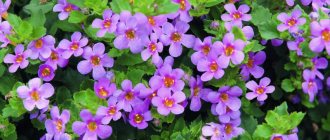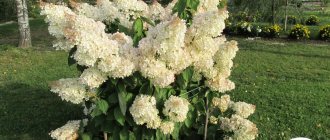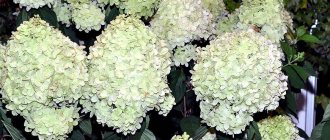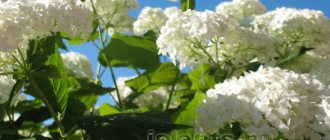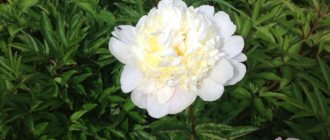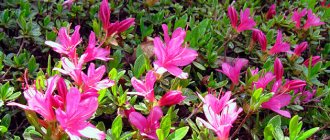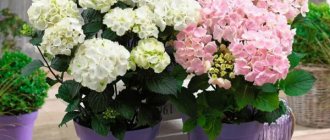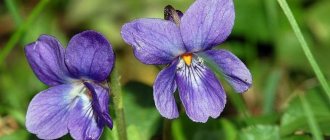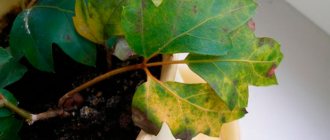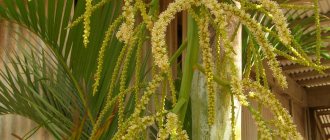Many gardeners have been growing white hydrangea for quite a long time. White hydrangea is considered a real decoration of the garden. The caps of these flowers are simply beautiful; they fascinate with their stunning appearance and unsurpassed aroma. That is why gardeners have been growing white hydrangea in their garden plots for a long time. In today’s article we will tell you about the origins of this crop, share with you a description of the variety, the secrets of propagation, planting and care rules, and at the end we will tell you how to properly prepare plants for winter and fight diseases.
About the history of the variety
White hydrangea: photo
Initially, hydrangea had only two colors: red and white, but sometimes gardeners say that there were pink and blue varieties. Breeders in many countries have worked hard to develop these varieties, so these large-leaved plants currently have a wide variety of species; the origin of the name of the crop is interesting. Currently there is more than one version.
The most famous is associated with the name of a flower in honor of a certain princess; she was so pretty that her brother named this beautiful flower after her. According to another version, hydrangea received such a beautiful name at the behest of a French doctor, namely in honor of his beautiful beloved. There is a more scientific explanation for such an interesting name for the culture. Since this plant is considered to be moisture-loving, it is also called hydrangia, which means a vessel with water. This culture is also called the purple sun; it is believed that the plant’s natural habitat is India, Japan, and America.
Varieties of hydrangeas
Hydrangea is very popular among gardeners; most of all, gardeners fell in love with tree and paniculate hydrangea. The first has huge snow-white spherical inflorescences, as well as very large leaves, so it crushes the tree, but paniculate hydrangea forms inflorescences shaped like panicles, but its leaves are slightly smaller. That is why these varieties received such names. Currently, the following varieties of hydrangea varieties are very popular: Anabel, white house, sterilis, hi star best and others. But most gardeners love to grow white hydrangea, since this crop is very unpretentious, its leaves are always large, so this plant perfectly decorates any garden. Hydrangea is often planted near houses and administrative buildings. The white lady variety is interesting, as is Grandiflora. In fact, there are a lot of varieties of white hydrangea, so you are sure to find something that suits your taste.
White hydrangea: description of varieties
White hydrangea: photo
It is believed that the birthplace of the globular white hydrangea is the United States of America. That is why the culture is considered very winter-hardy, so these plants can be grown in temperate latitudes, as well as in Siberia and the Far East. However, in severe winters the bushes sometimes freeze, so the plants should be covered. Shrubs of spherical white hydrangea are usually low, up to 2.5 m in height. The leaves are large, oval in shape, slightly ovoid, with a noticeable notch in the core and jagged edges. Leaves grow on drooping shoots, the leaves are bright green at the top, but bluish underneath.
The crown of the shrubs is also spreading and round in shape. Hydrangea inflorescences are also quite large, 25 cm long. Usually flowers form at the tips of annual shoots. Moreover, they are located on the plant very chaotically, usually at first the flowers are soft green, and then they become white, creamy, and milky. The seeds are collected in boxes, oblong and small in shape. White hydrangea begins to bloom in mid-summer and blooms very profusely, so before frost you can please yourself with the pleasant color of the inflorescences and aroma.
Types and features
The hydrangea genus (Hydrangea) has about 80 species.
Plants are tree-like, bushy or liana-like.
Before purchasing and planting a plant, you must carefully study the description of the hydrangea variety, since different types will require different care. For example, tree-like and large-leaved varieties need proper preparation for winter. And paniculate hydrangea calmly tolerates cold Russian conditions.
Hydrangea Bretschneideri Hydrangea Bretschneideri
Hydrangea Bretschneideri is a perennial shrub with a voluminous, spreading, rounded crown. The height of an adult bush can reach 4 meters in height.
The branches are covered with hairy chestnut-brown bark, which peels off in small thin plates. Upright shoots become woody at the beginning of cold weather.
The leaf blades are ovoid or elliptical, covered with villi underneath. Leaf length is from 7 to 12 cm.
The inflorescences are umbellate from 10 to 15 cm, consisting of white or pink flowers.
The flowering period begins in June and ends at the end of August. Flowering is long and abundant. Fruit formation is completed in October; in cold latitudes, the fruits do not ripen and go under the snow unripe.
The ornamental plant is distinguished by its unpretentiousness and beauty. Suitable for forming garden compositions and single plantings. The variety is frost-resistant and tolerates even harsh winters.
Tree hydrangea Hydrangea Arborescens
Hydrangea arborescens is a tree-like shrub with a lush, spreading crown. The height of an adult plant is from 1 to 2 meters. Crown diameter is from 2 to 3 meters.
The leaves are round, ovate. The upper part of the leaf blade is light green, the lower part is grayish.
Hydrangea inflorescences are corymbose, formed on the tops of annual shoots. The length of the inflorescences is from 20 to 30 cm. Subject to agrotechnical conditions, the inflorescences can grow up to 50 cm in diameter.
At the beginning of the flowering period, the flowers are pale green, the blooming flowers are white or cream.
During the flowering period, the crown must be tied up.
This is the most common type, which is widely used in professional and amateur design. The plant is frost-resistant and unpretentious.
Oakleaf hydrangea Hydrangea Guercifolia
Hydrangea Guercifolia differs from other varieties in the structure of the leaf blade, since the leaves of the plant are very similar to oak leaves.
The height of an adult plant is up to 2 meters, the crown volume is from 1 to 1.5 m.
The flowering period is from June to September. The inflorescences are lush, paniculate, about 20–30 cm in diameter.
The flowers are white at the beginning of the flowering period, then change color to purple.
Young shoots have a reddish tint, but as they grow they turn brown.
The description of oakleaf hydrangea states that it does not tolerate frost well. Therefore, the bushes should be well covered for the winter.
Hydrangea macrophylla
Hydrangea Macrophylla is a perennial shrub from 1.5 to 2 meters. The crown is lush, spherical. The leaf blade is rich green in color. Young shoots are erect and herbaceous, so the plant is not frost-resistant.
Umbrella inflorescences are formed on last year's shoots.
The flowers of this species are pink, blue, white or lilac.
The flowering period is from August to November. The color of the flowers depends on the pH level. There is no fruiting.
This type of hydrangea is suitable for growing at home. In winter, plants are placed on window sills, and when the weather warms up, they are taken out onto the loggia or veranda.
Hydrangea radiata
Hydrangea Radiata is an ornamental, heat-loving shrub. Height from 2 to 3 meters. The leaf blade is oval in shape with pointed tips. The photo of a garden hydrangea fascinates with its splendor. Leaf color is green. The inflorescences are corymbose, appear in early June and fade in July.
Hydrangea flowers are white, small in size, reminiscent of Buldenezh viburnum.
In winter, it is necessary to provide reliable shelter, since the plant is very sensitive to temperature changes.
Hydrangea paniculata
The hydrangea flower Hydrangea Paniculata is one of the largest representatives of the family. The height of an adult bush is about 5 meters. Young shoots have time to become woody before the cold weather, so the plant is considered frost-resistant.
Inflorescences are paniculate, pyramidal, formed on the tops of young shoots. Flowering is lush and long lasting.
At the beginning of flowering, the petals are pale green in color; after the buds open, they become white. In the middle of the period, the flowers turn pink, then acquire a brick tint, and at the end of flowering they turn dark green.
The flowering period is from June to September. The flowers have a pronounced pleasant aroma.
A distinctive characteristic of the species is its rare replanting. Paniculate hydrangea can grow in the same place for about 40 years.
Ground cover hydrangea Hydrangea Heteromalla
Bush hydrangea is variably pubescent - this species is often used by designers to create standard forms. Height is from 2 to 3 meters. The leaves are dark green, about 20 cm long. The leaf blade is smooth above, pubescent below.
Flowering period from late June to mid-August. The inflorescences are loose, corymbose-shaped.
The color at the beginning of flowering is white, and towards the end of the period it is pink.
Growing and caring for this type of plant in the garden is not difficult.
Ash hydrangea Hydrangea Cinerea
Hydrangea Cinerea is an erect ornamental shrub up to 2 meters in height. The leaves are green, ovoid in shape.
Hydrangea flowers are white and pale pink.
Inflorescences form in late June or early July. Flowering lasts until August. Frost resistance is average.
The species is often used to create low hedges in gardens, parks and squares. And also for creating alpine slides and flower arrangements.
Hydrangea Serrata
Hydrangea Serrata is a small, annual, tree-like shrub with a voluminous, spreading crown. Hydrangea bushes bloom in July and fade in September. The inflorescences have a beautiful and unusual color.
The inside of the flower is blue, but closer to the edge it becomes white.
The shape of the inflorescences is spherical.
Hydrangea Sargentiana
Hydrangea Sargentiana is a bush hydrangea that grows 2 to 3 meters tall. The crown is wide, branched. The flowering period is from August to September.
Umbrella inflorescences of a rare purple and lilac color.
At the end of flowering, the flowers turn white. The species is resistant to frost and is perfect for a summer cottage or garden plot.
Hydrangea Petiolaris
Hydrangea Petiolaris is a vine-like variety, with a mature plant measuring 20 to 25 meters in length. Perfect for decorating arches, gazebos and other compositions with a vertical direction.
Inflorescences are corymbose, painted white or pink.
A hydrangea shrub with lilac or pink inflorescences, planted near a vine, will complement the composition.
Hydrangea rough Hydrangea Aspera
Hydrangea Aspera is a distinct species of tree or shrub deciduous hydrangea. The height of adult plants is from 1.5 to 4 meters in height, the crown volume is from 1.5 to 2 meters.
The leaves are lanceolate, narrowly ovate or oval with a pointed tip. The edge of the leaf blade is jagged, the lower part is fleecy, the upper part is rough.
The shoots are erect, the crown is thick and dense. Young shoots are covered with villi; with age, the intensity of the hairiness decreases. The bark is gray-brown or deep brown.
Corymbose inflorescences are from 15 to 20 cm.
The flowers are white, purple, pink or lilac-blue.
The flowering period is from August to September. The fruits are small, box-shaped. The color of young fruits is green, then dark brown.
White hydrangea: propagation
White hydrangea, like many other crops, reproduces in different ways. Namely by cuttings , by dividing the bush , by layering and by sowing seeds . If you decide to plant seeds, then this must be done at the end of winter. Hydrangea is grown through seedlings. The seeds are planted in loose and nutritious soil, the first sprouts appear in about a month and a half. When the plants are formed, they will need to be planted in separate containers. In spring, the crop is planted outside.
Many people are engaged in cuttings, for this you will need to cut the cuttings in time. In order for the root system to form more intensively, the shoots will need to be treated with rootstock, and only then planted in different containers. To take cuttings, you should choose lignified branches. Typically, cuttings take root a month after planting. If you decide to replant white hydrangea, then you can divide the bush, usually this is done in the spring, cutting the root systems into two or more parts.
Layers also take root well. In order to propagate a plant using this method, you will need to bend a young branch, preferably an annual one, to the ground and sprinkle it with nutritious soil. Do not forget to water the cuttings; when the shoots take root normally, they can be separated from the main bush, usually this is done the next year.
White hydrangea: planting
White hydrangea: photo
White hydrangea loves slightly acidic, loose and fertile soil. But it is not advisable to plant hydrangea in sandy and acidified areas. There it will grow poorly. And you should not lime the soil either, since this crop does not like wood ash. It is advisable to plant hydrangea in an area well lit by the sun and also protected from the wind. It is best to plant this crop near any buildings so that cold air does not interfere with the development of the plant. If you have a lot of free space on your site, then plant hydrangea on the east side. There it will grow intensively. In order for hydrangea to grow normally, leave two meters between plantings. Usually this crop is planted in open ground at the end of spring, in May, when the ground has warmed up considerably and the frosts have finally subsided.
Over the summer, white hydrangea has time to take root well, which means it will overwinter normally. In southern latitudes, this crop is sometimes planted in the fall, where hydrangea also grows well at this time. The planting pit will also need to be prepared in advance, about a month before the planned date of the hydrangea exhibition in open ground. It should be approximately 50 cm deep and up to half a meter wide. However, you should consider the size of the seedlings' root system. Therefore, the dimensions of the pit may also vary. Gardeners often recommend taking soil from under coniferous trees; hydrangea grows beautifully on it. Before planting a shrub, it is recommended to shorten all annual shoots by several buds. The seedling is placed in the center, the root system is well straightened and only after that the holes are filled with a fertile mixture. Don't forget to compact the soil surface and water the plants generously. For this you will need at least one bucket of water.
Sometimes gardeners immediately mulch the top layer of soil, and for this they use sawdust, dry grass, and tree bark. This helps retain moisture and get rid of weeds. If you want the seedlings to start blooming early, then they should be planted closer to each other, eighty cm apart, but after two years the plantings should be thinned out. The root collars cannot be buried; they must rise above the surface of the earth.
How to plant
It should be noted that the process of planting the shrub in question in open ground is quite simple and does not require any special skills from the gardener. In order for the plant to feel as comfortable as possible, it is necessary to choose the right place for it. The ideal option for planting cuttings would be on the sunny side, where there will be no long-term shading.
As for the disembarkation period, it is also of no small importance. So, this process is best done in the warm spring or autumn months (May or September).
As for the process of immersing the rhizome of the cutting into the ground, to do this you need to first dig a small hole, the depth and width of which will reach 50–60 cm.
At the bottom of the formed hole, it is necessary to lay out a special mixture necessary to improve the growth process of the plant, as well as fertilizer (we’ll talk about what should be included in these components later). After this, you need to immerse the cutting there. When planting a plant, you should take into account that its root collar should be located at soil level.
At the final stage of planting, the shrub must be watered abundantly so that the roots are saturated with sufficient moisture. Only in this way will they gain the necessary strength and quite quickly enter the phase of active growth and development after initial care and planting.
Garden hydrangea has some requirements for its placement in the soil. In order for the plant to feel comfortable, during planting it is necessary to leave a certain distance between the bushes - about 1.5 meters. Thus, they will be able to grow properly without interfering with each other, and will also look quite impressive and bright, delighting garden guests with their powerful and abundant flowering.
White hydrangea: care
As you understand, white hydrangea is considered moisture-loving, so it is necessary to moisten the soil quite often. Every week, up to twenty liters of water are carried into the soil. It is best to use rain moisture for this. If there is excess rainfall in your region, then the crop should be watered 4-5 times during the summer. If the soil dries out, this will not have a favorable effect on the development of hydrangea. Therefore, in such conditions, the crop develops worse, and winter hardiness decreases.
To prevent plants from getting sick, experienced gardeners add a little potassium permanganate to the water for irrigation. It is best to irrigate the soil either early in the morning or late in the evening. And in order to better preserve moisture, the soil is mulched. If the autumn is also quite dry, then the crop should be watered at this time. And do not forget to loosen the soil after watering so that an earthen crust does not form.
Usually it is not recommended to feed seedlings for 2 years, but at the age of three it is recommended to add microelements to the soil; complex mineral fertilizers are suitable for this. When buds begin to form on the plant for the first time, the hydrangea should be fed with superphosphate. And at the end of summer, add a little potassium sulfate to the soil. Gardeners often water the bushes with liquid mullein, as well as chicken droppings, previously diluted in water. Sometimes the soil is fed with lactic acid. However, it is undesirable to overfeed this crop, since excess nitrogen in the soil negatively affects plant development. It is strictly forbidden to introduce wood ash into the soil.
Don't forget about pruning plants. It is better to remove unnecessary shoots in early spring, before sap begins to flow. To make shrubs bloom more abundantly, you will need to remove small buds from the bush in the first years and thin out the remaining shoots. In early spring, it is recommended to carry out sanitary pruning; sometimes old shrubs are rejuvenated by removing all diseased, old and dried branches. Shorten the shoots by about 5 buds. By radically rejuvenating the shrub, gardeners cut off all the shoots at the roots; young shoots will begin to grow in the next season.
Features of care during the flowering period
In order for the plant to develop correctly and undergo all vegetative cycles on time, a set of different measures is necessary. Here are the main ones:
- Regular moistening with settled or rain water - 25-30 liters per week; in hot weather, you can water it more often.
- Mulching, loosening and weeding the circle near the rhizome - three times during the summer.
- In the spring, use bait with nitrogen, and during the period when it begins to bloom - fertilizer with potassium, once every 14 days.
- Annual cutting of branches to rejuvenate and shape the plant.
- The best soil is a mixture of peat, sand and turf in equal proportions.
In preparation for the rest period, it is necessary to remove the foliage, tie the hydrangea in a bunch, do hilling, and install supports.
Attention! To prevent large inflorescences from breaking the stems, it is recommended to use support fences around the bush.
Frost resistance
In open ground in the garden, paniculate and tree-like types of hydrangea are most often grown. Despite the fact that they are considered cold-resistant, young plants require shelter during the frost period. Over time, the shrubs become more resistant to winter, and after the 4th year of existence they no longer need to be covered.
Regular pruning of branches
White hydrangea: preparation for wintering
White hydrangea: photo
Typically, plants begin to be prepared for wintering in September. Faded inflorescences will definitely need to be removed and the branches bent low to the ground. To make it more convenient for you, they can be tied. This is done so that the shoots do not break under the weight of the snow. It is recommended to cover seedlings that are too young. To do this, the root zone is covered with fallen leaves. In general, this crop is considered winter-hardy, so these plants are grown even in Siberia and the Far East. However, there it is necessary to cover the plants with fallen leaves and agricultural material. Bushes are usually covered with burlap and spruce branches. Before frost arrives, the tree trunk circle is covered with peat or compost.
After this, the shoots are pulled together and covered with some kind of breathable material. However, it is not recommended to use film for this, since moisture accumulates under it and the shoots begin to rot. In March, the shelter is removed and the mulch is also swept away, but if the frosts have not yet completely receded, then you need to wait until at least April. If certain varieties of hydrangea are not winter-hardy, they are recommended to be replanted in boxes. In this case, you will need to remove all the leaves from the bushes, and then transfer the plants to the basement.
Hydrangea: planting and care
When you see these flowers, you get a feeling of airiness and lightness; you want to pick a huge fluffy bouquet or plant whole rows of hydrangeas so that there are colorful hats on both sides of the garden path. The plant belongs to the Hydrangeaceae family. Most often these are small trees or shrubs, but there are even vine-like forms. The flowers are small, collected in large spherical inflorescences, without aroma. Thanks to these beautiful inflorescences, hydrangea is impossible to miss.
Hydrangeas
It turns out that hydrangea is not only beautiful, but also healing! Read about its use for medical purposes in the article “Healing Hydrangea.”
White hydrangea: diseases and pests
White hydrangea has good immunity, however, when planting the crop in the wrong soil, insect pests may appear on the site. If hydrangea gets chlorosis, this indicates an excess of lime in the soil. Therefore, you should spray the foliage with copper sulfate. Sometimes this crop suffers from powdery mildew. This is due to the fact that the surrounding air is very humid, so the plants also need to be sprayed with copper sulfate, and in order for the preparations to better adhere to the surface of the foliage, they should be treated with a soap solution. Sometimes green aphids settle on hydrangea leaves. These pests do not like garlic, so this plant can help you fight these harmful insects. Spray the foliage with garlic tincture every day for a week, after which the pests usually leave the area.
